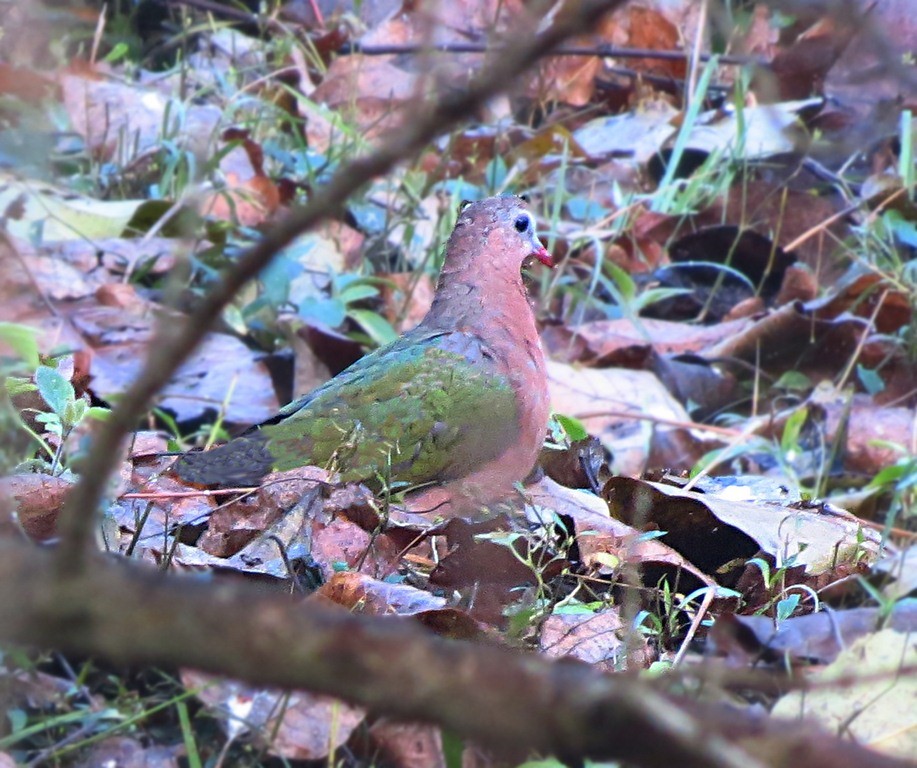Common Emerald Dove
A species of Emerald Doves, Also known as Gray-capped Emerald Dove, Emerald Dove Scientific name : Chalcophaps indica Genus : Emerald Doves
Common Emerald Dove, A species of Emerald Doves
Also known as:
Gray-capped Emerald Dove, Emerald Dove
Botanical name: Chalcophaps indica
Genus: Emerald Doves
Content
Description People often ask General Info
 Photo By Soumyadeep Chatterjee . , used under CC-BY-SA-2.0 /Cropped and compressed from original
Photo By Soumyadeep Chatterjee . , used under CC-BY-SA-2.0 /Cropped and compressed from original Description
The common emerald dove is a stocky, medium-sized pigeon, typically 23–27 cm (9.1–10.6 in) in length. The back and wings are bright emerald green. The flight feathers and tail are blackish, and broad black and white bars show on the lower back in flight. The head and underparts are dark vinous pink, fading to greyish on the lower belly. The eyes are dark brown, the bill bright red and legs and feet rufous. The male has a white patch on the edge of the shoulders and a grey crown, which the female lacks. Females will tend to have a browner complexion with a grey mark on the shoulder. Immature birds resemble females but have brown scallops on their body and wing plumage. 
Size
27 cm
Colors
Brown
Green
Red
Gray
Pink
Life Expectancy
10-15 years
Nest Placement
Ground
Feeding Habits
Common Emerald Dove primarily consumes seeds and fruits from diverse plants. It showcases unique foraging behaviors, favoring certain fruits for its diet. Lacking specific hunting techniques, common Emerald Dove searches for food mostly during the day. No distinct dietary adaptations noted.
Habitat
Common Emerald Dove predominantly inhabits tropical forest ecosystems such as primary rainforests, wet sclerophyll forests, and dense woodlands, including specialized habitats like mangroves and gallery forests. This species thrives at forest edges and has adapted to human-altered environments like orchards and plantations near forests. It occupies regions up to 2200 meters in the Himalayas and lower elevations in Southeast Asia and Borneo.
Dite type
Granivorous
People often ask
General Info
Feeding Habits
Bird food type
Behavior
Emerald doves usually occur singly, pairs or in small groups. They are quite terrestrial, often searching for fallen fruit on the ground and spending little time in trees except when roosting. They eat seeds and fruits of a wide variety of plants and are generally tame and approachable. Its flight is fast and direct, with the regular beats and an occasional sharp flick of the wings which are characteristic of pigeons in general. It often flies low between the patches of dense forest it prefers, but when disturbed will frequently walk away rather than fly. They are particularly good weavers when flying through forests. When flying they expose a buff underwing and a chestnut colour of their flight feathers. The call is a low soft moaning cooing consisting of about six to seven coos starting quietly and rising. They also call a nasal "hoo-hoo-hoon". Males perform a bobbing dance during courtship. 
Distribution Area
This is a common species in tropical forests and similar dense wet woodlands, farms and mangroves. It builds a scant stick nest in a tree up to five metres and lays two cream-coloured eggs. 
Species Status
Not globally threatened.
Scientific Classification
Phylum
Chordates Class
Birds Order
Pigeons and doves Family
Dove Genus
Emerald Doves Species
Common Emerald Dove